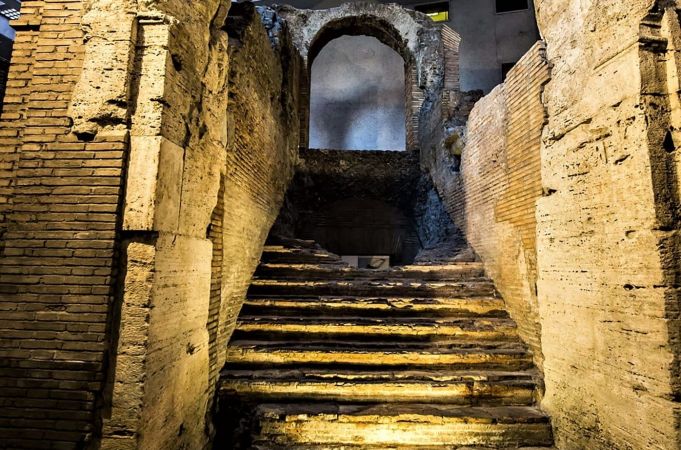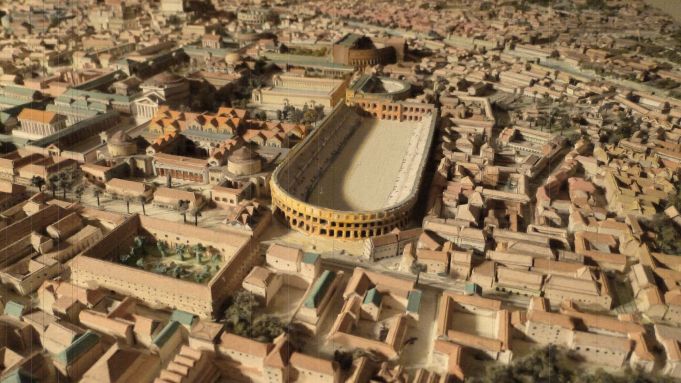Rome's ancient ruins of the Stadium of Domitian can be visited under Piazza Navona.
As you quietly sip a coffee in Piazza Navona, a pinch of zest is added by the thought of being seated in what once would have been the path of professional athletes hurtling naked round Domitian’s Stadium.
As well as the shape of the piazza, the link is there in the name. Evoking Greek athletic contests of ancient times, the mediaeval “Piazza d’Agone” with a consonant shift comes down to us as Piazza Navona. Even closer to the mediaeval name is that of the church of S. Agnese in Agone, designed by Borromini, which is the backdrop to Bernini's Fountain of the Four Rivers. By another stretch of imagination, you might be underwater. The structure was occasionally flooded for mock naval battles – naumachie – accounting for the present name’s initial syllable, a practice revived in the 18th and 19th centuries, when on August weekends Roman prelates and nobles processed in carriages, their axles peaceably paddling water.
Underground museum
At the square’s still curved Via Agonale end, after a 12-mt descent, thanks to the Piazza Navona underground museum it is possible to enter the stadium anew, passing through the original brick mixed with other material to withstand earthquakes. (The marble overlays were carried away by the Byzantine emperor Constantius II in 356 AD to adorn his eastern capital.) Travertine slabs and stretches of the stadium’s original paving prove that in Rome for every sight above ground, others lie beneath. For the 120 arches, sand-covered area and the athletes themselves, one has to make do with a giant video re-construction.
Olympia
But why athletes, not gladiators? The answer is in the Roman elite’s predilection for things Greek. To quote English historian Edward Gibbon, "victorious Rome was itself subdued by the arts of Greece." Indeed, the stadium arena, 192mt long and 54mt wide, replicates almost religiously the stadium in Olympia. As in Greece, the games were held every four years. The athletes were, yes, Greek or from its surrounding regions, the victors being guaranteed Roman citizenship. Via a mosaic from the Baths of Caracalla, one hulky specimen – naked but for laurel palm and crown – appears in the Vatican Museums.
Actually, after a fire in 217 damaged the Colosseum, the stadium would host gladiators as well; and unlike Rome’s circuses, no central section (spina) or horses’ starting traps (carceres) impeded the view.

Though Domitian (81-96 AD) was not without a bloody streak himself – Suetonius, that ancient gossip, wrote decades after Domitian's death that the emperor’s favourite pastime was pulling the wings off flies – this did not preclude a desire to promote "contests that strengthened the body instead of destroying it" (Carcopino, Daily Life in Ancient Rome).
Blood sports
Thus the public might be weaned off blood sports, human as well as animal, in the Colosseum. True, the end of Domitian’s reign was characterised by political murder, particularly of senators. However, with their confiscated riches he could fund palaces and stadiums, plus pay rises for the mostly faithful army. And it is there in esercito or exercise, as Gibbon points out, that the Italian word for army derives. Even now many Italian Olympians come for the same institution.
In nearby Campo Marzio, generations of troops were trained, "the exercises comprehending whatever could add strength to the body and grace to the motions." In the midst of peace, adds Gibbon, "recruits were instructed to march, to run, to leap…" His list ends with "to move to the sound of lutes, in Pyrrhic or martial dance." Latin’s "Mens sana in corpore sano" reflects the Greek idea of games that incorporated music and dance.

Promoting athletes, not gladiators, Julius Caesar had also tried to soften public taste, constructing a wooden stadium in the same Campo Marzio area to celebrate his triumph. His successor Augustus instituted the four yearly Actiæ games to celebrate his victory at Actium. Alas, by AD 14, with the death of Augustus, the Actiæ vanish from the record, presumably for lack of interest. After gladiator shows and chariot races, such games must have seemed tame.
Nero's chariots
Nero (54-68 AD) tried with his four-yearly Neronia, the games including music contests. Public disaffection partly derived from the emperor’s character. The thrill of competition must have been dampened, knowing how the winner, against all athletic odds, would probably be Nero himself. He could flaunt 1,808 trophies. One victory was in Olympia, Greece, sport’s holy of holies. Nero’s ten-horsed chariot (other competitors had four-horsed ones) crashed on the first lap. That didn’t stop him being adjudged the winner anyway. Another story narrates that during a singing competition in Naples the audience had to sit through an earthquake as Nero insisted, don’t worry; it was only the gods applauding him.
Lord and god
At least Domitian refrained from competing. He did, though, like previous emperors make a point of attending. Not only as top spectator, but dominus et deus, lord and god. The public (potentially 30,000, discounting the larger numbers mesmerised by the gore up at the Colosseum) could also behold the emperor in purple mantle and golden crown to include a seated Jove, Juno and Minerva, the Capitoline Triad. As if this wasn’t showy enough, his imperial person was flanked by Jove’s priest. Following enviously, so historians claim, in the footsteps of his more popular brother Titus, who had inaugurated the Colosseum with 100 days of games, Domitian could offset the senate’s hostility by currying favour with the people.

Emperors used sport "as an instrument of their absolutism." Carponcino again. "A people that yawns is ripe for revolt…" Meanwhile senators must have mulled over their property confiscated to help fund just such a spectacle. Once back in his lavishly extended palace on the Palatine, Domitian would keep a wary eye out for potential assassins. Death came in an inner room, a senate-based plot encouraged by Domitian’s estranged wife, Domitia.
Pasquino
In the subsequent damnatio memoriæ (whereby new emperors sought to cancel all reference to their predecessors), Domitian’s statues and other regalia were torn down. The statue of Menelaus (originally holding the body of the dying Patroclus) survives as the renamed and better-known Pasquino in the homonymous square round the corner from Piazza Navona.
Severans
Not that the stadium fell into dilapidation. There is its already-instanced use as substitute Colosseum. It pops up again at the British Museum on a gold coin minted under the Severans under whom it was restored then renamed Circus Alexandri in the short-lived reign of Alexander Severus.
Sports
And the events themselves? Making the museum a sine qua non for any team visiting Rome, wall-panels illustrate the disciplines one by one: the javelin with obvious military applications. Leaping long-jumpers carrying then jettisoning a pair of 2 kg weights (halteres) to propel them farther – a military application for crossing enemy lines? The diaulos, twice the length of the stadium, equivalent to our 200-m sprint. Then the long-distance dolichos. Known as oplitodromia, the same distance was also run with shield and helmet: an equivalent might be our 3,000-m steeplechase, the obstacles outside rather than “on” the competitor? The lampadedromia, a relay race, involved torches, not batons; for visual appeal.
Blinding or death
Wrestling was no holds barred. A point for the World Wrestling Federation and its audience rankings to consider, it sometimes pitted men against women, pre-match preparations involving body-powder and olive oil. As in boxing, categories went by age not weight. Far more brutal than today’s Olympics with their protective head-gear, contests in both disciplines could only be stopped, barring submission, by blinding or death. Boxing gloves were leather straps (himantes), often with metal “padding” as worn by the ancient Greek bronze sculpture Boxer at Rest at Palazzo Massimo alle Terme. Flesh turned bronze, note the swollen right eye and ears, flattened nose, upper jaw missing its teeth. Due to the sculptor’s skill, the greenish patina still comes flecked with red gashes, suggesting blows inflicted seconds before as the athlete catches breath between rounds.
Bernini
Time to climb the narrow staircase back up into the present. The most athletic element in sight is Bernini’s tirelessly (and high-jumping) water fountain. A refreshing spritz prompts the observation, how eminently Greek it all seems except for the Egyptian obelisk on top of Bernini's Fountain of the Four Rivers in the middle of the square. On the orders of Innocent X, it was transported to Piazza Navona in five massive fragments from Circo Massenzio on the Via Appia. With Borromini’s, then Bernini’s help, the Pamphilj pope intended Piazza Navona as the city’s new epicentre, converting the former race-track into “Rome’s drawing room”, the ideal venue in which to sit back, gaze and admire.
By Martin Bennett
The stadium can be visited at Via Tor Sanguigna 3 from Sun-Fri 10.00-19.00 and Sat 10.00-20.00. This article was published in the December 2019 edition of Wanted in Rome magazine.
General Info
View on Map
Rome: Piazza Navona's underground stadium
Via di Tor Sanguigna, 3, 00186 Roma RM, Italy

















